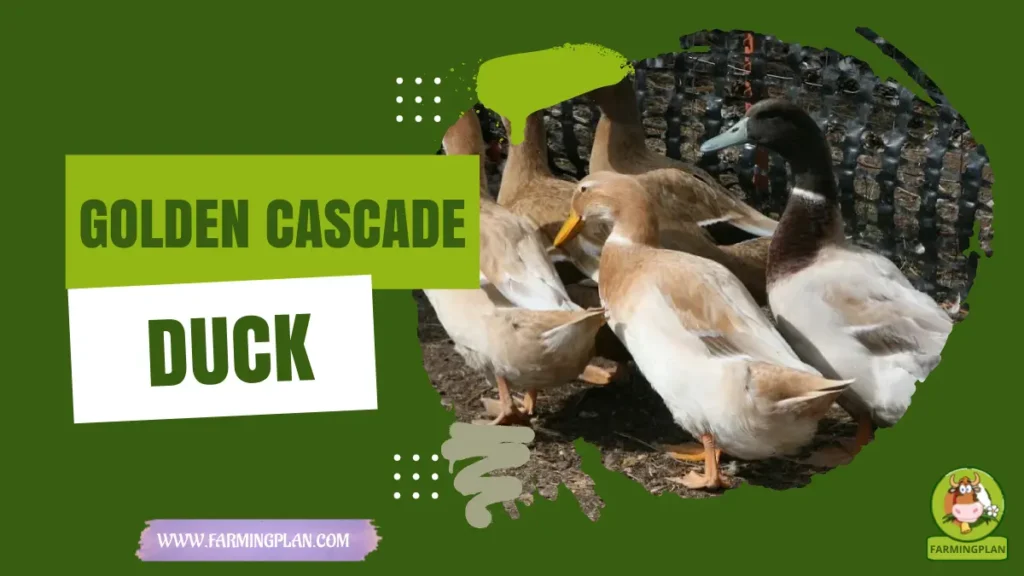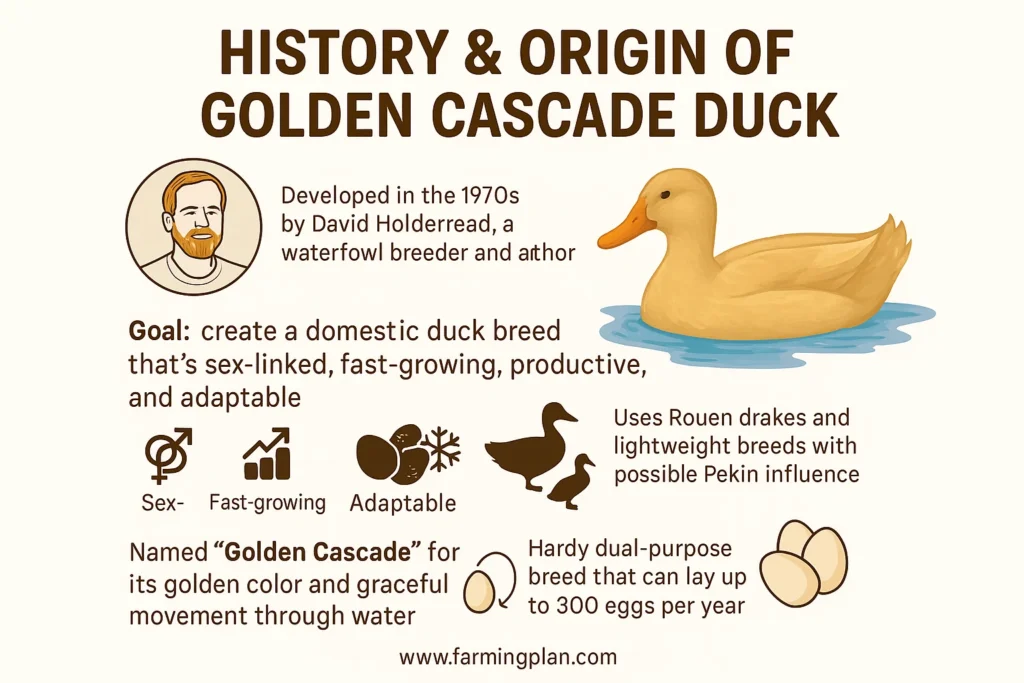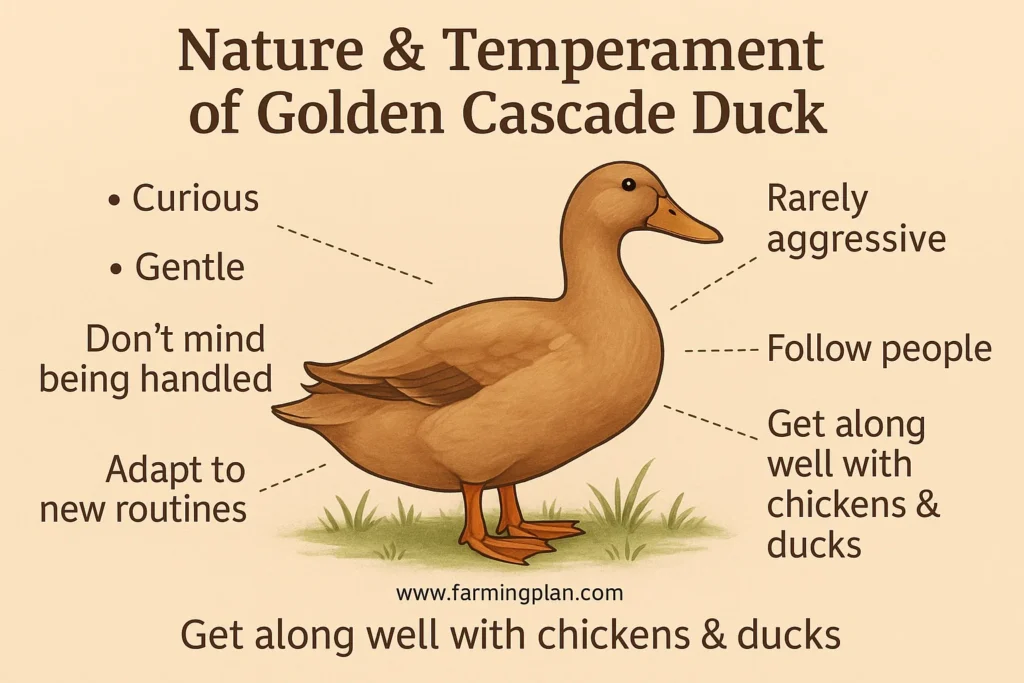The Golden Cascade Duck was developed in the 1970s by David Holderread, a renowned waterfowl breeder, with a clear goal: to create a hardy, fast-growing, weather-resistant duck that could be sexed easily at a young age and excel as a dual-purpose bird. Using Rouen drakes, lightweight breeds, and possibly some Pekin influence, he crafted a duck that lays up to 300 eggs a year and also produces quality meat when processed young. The breed’s name reflects its golden plumage and elegant movement in water. Though still rare outside the U.S., the Golden Cascade is a favorite among those who raise them for both beauty and productivity.

History & Origin of Golden Cascade Duck
The Golden Cascade Duck has a pretty interesting backstory. This breed was developed in the 1970s by David Holderread, a well-known waterfowl breeder and author. David’s goal was simple but smart: create a domestic duck breed that’s easy to tell apart by sex at an early age, grows fast, lays plenty of eggs, and thrives in all kinds of weather. Talk about a wish list!

Holderread started with Rouen drakes, some lightweight breeds, and maybe a bit of Pekin influence to create what would become one of the most reliable dual purpose ducks on the market. The result? A hardy duck that produces up to 300 eggs a year and can be processed at a young age for quality meat. He named the breed “Golden Cascade” to reflect their beautiful golden tones and the graceful way they move through water—like a living cascade. They’re still pretty rare, especially outside the U.S., but for those of us who’ve raised them, they’re a breed worth bragging about.
Read More: Mulard Duck: Bold Flavor & Top Farming Choice
Characteristics of Golden Cascade Duck
Golden Cascades are easy to spot once you know what to look for. Ducks (females) have a soft golden or buff color, and their heads can carry a tan tint with light eye stripes. The drakes (males), though, are where things get flashy. They often come with a bright reddish chest, white ring around the neck, and green or bronze-tinted head coloring—something you don’t see in many other breeds. I call my lead drake “Handsome Henry” for a reason!

Their webbed feet are strong, perfect for waddling around the yard or splashing in constant bathing water. They’re medium-sized birds, lighter than Rouens but bigger than some bantam ducks. Their body has a nice meat-carrying shape, and the breast is full without being bulky. When they’re still ducklings, you can usually sex them based on their coloring—females tend to have darker bills and markings, while males start lighter. That’s a bonus for folks ordering golden cascade ducklings for sale online—you’ll likely know what you’re getting before they even leave the post office.
Read More: East Indie Duck: Backyard Beauty
Nature & Temperament of Golden Cascade Duck
Out of all the duck breeds I’ve raised, Golden Cascades have some of the best personalities. These ducks are curious, gentle, and rarely aggressive—even the drakes. They’re perfect if you’re introducing ducks to kids or want a friendly breed that doesn’t mind being around people.

They’ll waddle over to me every morning at feeding time and often follow me around the yard. They don’t mind being handled, especially if you raise them from ducklings. Even previous ducks I had from other breeds would sometimes get spooked easily—but not these guys. They adapt quickly to new routines and are smart enough to learn where their duck house is by day three. If you’re raising ducks as pets or for a hobby flock, they fit right in. They get along well with chickens and other ducks, and I’ve even had them share bathing water with our geese—no drama at all.
Read More: Alabio Duck: Local Indonesian Breed
Food & Diet
Feeding your Golden Cascades isn’t rocket science, but there are a few things to keep in mind. When they’re ducklings, I give them non-medicated starter crumbles with extra niacin. Ducks need more niacin than chickens to keep those webbed feet strong and healthy. You can also crush up brewer’s yeast and sprinkle it on their food.
Once they grow, switch to a grower or layer pellet depending on your goal—meat or eggs. I always offer fresh greens, oats, peas, and let them free range for bugs. They love rooting around near water, so make sure they’ve got a shallow pan or kiddie pool to dip their heads and rinse off. Just don’t feed them bread, chips, or sugary foods. That stuff can bloat them or cause long-term issues. Keep clean water nearby at all times, especially during the warmer months. Ducks get dirty fast, and hydration keeps them laying well and digesting food better.
Usage & Purpose
Golden Cascades are true dual purpose ducks. I raise mine for both meat and fresh duck eggs. The hens start laying at around 5–6 months, and if you keep their nesting area comfy and dry, you’ll get 5–6 eggs a week. The eggs are large, white, and delicious—I use them for baking, and the yolks are rich and creamy.
If you’re raising for meat ducks, they can be ready for processing at 7–10 weeks. Their fast growth rate and balanced breast meat make them a favorite for small-scale farms or backyard growers who want quality protein on the table. They’re also a great breed of water birds for 4H projects or homestead pets. Easy to manage, sociable, and they look great waddling around a pond or pasture.
Raise Ducks Like Family—Golden Cascades Will Quack Their Way Into Your Heart And Onto Your Farm With Purpose.
Special Features
There’s plenty to love about this breed, but here are some standout traits:
- Auto-sexing ducklings: That’s a major win for anyone who doesn’t want to wait months to know if they’ve got a drake or a duck.
- Hardy in cold and heat: I’ve raised them through snowy winters and steamy summers—no complaints from them.
- Efficient egg layers: They rival some of the top egg-laying duck breeds.
- Fast growers: Great for folks looking to process ducks young.
- Beautiful color varieties: Those head coloring variations in drakes add charm to any flock.
Health Issues & Prevention
Golden Cascades are pretty hardy, but like any domestic duck, they do need regular care. The main issues I’ve seen are:
- Bumblefoot: Happens when they walk on rough surfaces too much. Keep bedding soft and dry.
- Worms and parasites: I deworm my flock twice a year and keep their water areas clean.
- Wet feather syndrome: This occurs if ducks don’t have access to clean bathing water. Give them daily access to constant bathing water—even a baby pool works.
Regular health checks, clean coop conditions, and fresh food go a long way. Also, watch for signs of respiratory distress. If a duck’s breathing looks odd or you hear wheezing, isolate and treat right away. A little prevention keeps your whole flock of ducks happy.
Step-by-Step Duck Raising Guide
Step 1: Set Up the Brooder for Ducklings
I start with a large plastic bin or stock tank lined with pine shavings (never cedar). I use a heat lamp hung safely above—ducklings need 90°F the first week. Each week, I drop the temp by 5°F until they’re feathered. Keep food, water, and niacin-rich starter feed nearby. Ducklings are messy. Clean bedding daily and change water twice a day. I always label the batch of ducklings by hatch date and note how they’re growing. By week two, they’ll start dabbling in water like mini pros.
Step 2: Move to Outdoor Coop or Duck House
By 4–5 weeks, I move them to a predator-proof duck house. It should have good ventilation, straw bedding, and a low door they can waddle through. Golden Cascades don’t roost like chickens, so low platforms or bare floor work fine. Give them access to an enclosed yard and clean bathing water. I’ve used kiddie pools, cement mixing trays, and even converted troughs—they’re happy as long as they can dunk their heads.
Step 3: Feeding & Growth Monitoring
As they grow, I switch to grower pellets around 6 weeks. I also supplement with garden scraps, peas, oats, and bugs. By 8 weeks, you’ll know your cute drake feathers from your layers. If processing, mark your age for processing ducks at around 9–10 weeks. Keep an eye on their weight and energy levels. If a duck’s falling behind, separate and give extra feed time. They’re fast growers but still need individual attention.
Expert Tips & Best Practices
- Always order extras: A few ducklings may not make the post office trip—order a couple more than you need.
- Rotate bathing water: Dirty water leads to illness. Refresh it daily.
- Train early: Get them used to your voice and presence as previous ducklings remember faces.
- Give them variety: Ducks get bored! Rotate treats like watermelon rinds, lettuce, and peas.
- Avoid metal pans: They get too hot or cold. Use plastic or rubber feeders and waterers.
FAQ
Are Golden Cascade Ducks good egg layers?
Yes, they lay up to 300 eggs per year and start laying as early as 5–6 months.
Can Golden Cascade ducklings be sexed at birth?
Usually, yes. Their color patterns help distinguish drakes from ducks at hatch.
How big do Golden Cascade Ducks get?
They reach about 5–6 pounds, with drakes slightly larger than females.
Are Golden Cascades noisy?
They’re moderately vocal. Not silent, but not nearly as loud as some breeds like Khaki Campbells.
Can they live with chickens?
Yes! Just make sure each has proper feed and separate sleeping areas if needed.
Conclusion
Raising Golden Cascade Ducks has been one of the best decisions for my farm. They’re friendly, beautiful, and do double duty by giving you both meat and eggs. Whether you’re hatching your first batch of ducklings or adding to your flock of ducks, this breed brings joy, efficiency, and charm. If you’re looking for a reliable breed of water birds that’s as practical as it is pretty—don’t pass up the Golden Cascade. Start with a few Spring ducklings and see for yourself why these ducks are winning hearts (and breakfast tables) everywhere. Ready to dive in? Go find some golden cascade ducklings for sale and let the quacking adventure begin!

